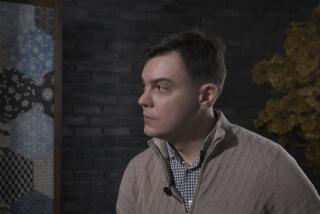Lazar M. Kaganovich; Stalin Lieutenant
- Share via
MOSCOW — Lazar M. Kaganovich, the last surviving political lieutenant of Josef Stalin and a key engineer of the Soviet dictator’s bloody farm collectivization drive and terror campaigns of the 1930s, has died at age 97, the Tass news agency reported Friday.
Tass gave no further details. But with the passing of Kaganovich, an era in Soviet history came to an end. The mustachioed, Ukrainian-born Jew was the last of Stalin’s “faithful comrades-in-arms”--the inner Kremlin circle that included Vyacheslav Molotov, Lavrenti Beria and Georgy Malenkov--who helped create Stalin’s brand of totalitarianism.
Kaganovich, who joined the Bolshevik Party when he was 18, played a “sinister role” in the years of Stalin’s terror, according to Soviet historian Roy Medvedev. The head of the Ukrainian Communist Party organization in 1925-28 and the national party’s No. 2 official in 1932-34, he exposed supposed “wreckers” in transport and helped conduct a purge of the Byelorussian party apparatus that wiped out more than half of the organization.
As early as 1932, Kaganovich helped wage ruthless terror in the northern Caucasus that resulted in the deportation en masse of the inhabitants of large Cossack villages. As first secretary of Moscow’s Communist Party organization in 1930-35, he was responsible for the construction of the capital’s subway and the eradication of many historical monuments and churches.
Some Western historians have seen in Kaganovich the archetypal manager of the Stalin era, a party apparatchik willing to get things done regardless of the human cost. He was head of the Communist Party’s agricultural section for a time and thus personally involved in the liquidation of the private holdings of the Soviet peasantry, a long and violent operation that led to millions of deaths and badly damaged the country’s ability to feed itself.
During World War II, as People’s Commissar for Railways, Kaganovich organized the shipment of the vast stocks of machinery and ammunition that the Red Army used to defeat the Nazis.
Fellow Ukrainian Nikita S. Khrushchev, a former protege, was the man who brought about Kaganovich’s political ruin. Khrushchev became Soviet leader after Stalin’s death in 1953 and, four years later, Kaganovich and other members of the so-called “anti-party group” tried to get rid of him.
Kaganovich was officially disgraced and lost all posts. He was expelled from the Communist Party in 1961.
In his memoirs, Khrushchev wrote that Kagonovich was “unsurpassed in his viciousness,” and that “he played the part of a vicious cur who was unleashed to tear limb from limb any member of the Politburo towards whom he sensed Stalin’s coolness.”
A pensioner since 1961, Kaganovich lived in a small two-room flat on Moscow’s Frunzenskaya Embankment. He generally shunned contacts with foreign journalists, but an Italian reporter managed to see him last year and reported that his eyesight was failing and that he walked on crutches due to a hip fracture. With fervor, Kaganovich defended his own role and that of Stalin in Soviet history.
As the sole Jew in Stalin’s Politburo, Kaganovich came under intense criticism in recent years from Russian nationalists who accuse him, rather than Stalin himself, for some of the worst crimes of the Stalin era.
Medvedev, an expert on the period, rejected such an interpretation of the historical record, noting: “The list of Kaganovich’s grave crimes before the party and the people is very long. And yet, Kaganovich was merely one of Stalin’s underlings--the same as Molotov, Zhdanov, Voroshilov, Yezhov and Beria.”
More to Read
Sign up for Essential California
The most important California stories and recommendations in your inbox every morning.
You may occasionally receive promotional content from the Los Angeles Times.













